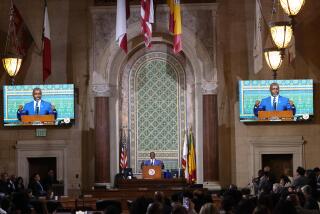Keep Moving Forward, Keep Moving Left
- Share via
The issues shaping this year’s mayoral campaign may lead voters to conclude that this is a historic moment of social progress in Los Angeles. That’s true enough. But the campaign also reflects a history of left-leaning activism that has been pushing the city forward for a century.
The city got a reminder of its progressive past in 1998, when veteran activists packed Keck Theater at Occidental College to discuss their roles in pivotal Los Angeles political battles. The aging firebrands spoke of defending the young Mexican Americans dubiously charged in the infamous 1943 Sleepy Lagoon murder trial. They recounted fighting for public housing and against the bulldozing of Latino families’ homes in Chavez Ravine to make room for Dodger Stadium in the 1950s. And they told of building coalitions in 1969 to support Tom Bradley against the incumbent mayor, Sam Yorty.
Soon after the conference, grass-roots activists and progressive policy analysts got together and drew up a blueprint for the city’s future. Unveiled during the 2001 mayoral campaign, their “21 Point Agenda” identified such key goals as creating a housing trust fund to stimulate affordable-housing construction; establishing community-benefits agreements for any new major development, such as LAX expansion; developing new farmers markets and community gardens; extending the living-wage ordinance; and providing for a string of parks along the Los Angeles River. Some activists were disappointed that James Hahn beat Antonio Villaraigosa, the favorite of most progressives.
But as the agenda continued to frame subsequent political debates -- including the current one -- they could take consolation in having kept aflame a torch that had been burning not just since Sleepy Lagoon but at least since 1911, when the Socialist candidate for mayor, Job Harriman, and eight of his running mates for City Council placed first in the municipal primary election.
Campaigning on a platform that included a democratically controlled municipal utility, opposition to the use of the new L.A. aqueduct for real estate speculation, promotion of women’s suffrage, support for a living wage and the demand for an end to the anti-labor “open shop” policies of the city, Harriman and his activist allies created a powerful progressive coalition of women, working-class voters and members of the budding African American community. Defeated in the runoff because of the effective mobilization of business interests, challenges that disenfranchised voters and a last-minute guilty plea by labor activists who had bombed the Los Angeles Times building, Harriman’s coalition nevertheless was able to ensure key agenda changes, such as public ownership of the electric utility (subsequently called the Department of Water and Power).
In 1938, a labor and progressive-led coalition of reformers and radicals successfully brought about the recall of corrupt Mayor Frank Shaw and the election of a Superior Court judge, Fletcher Bowron, as mayor. The Los Angeles Times, then the leading conservative voice in the city, characterized Bowron as an “honest reformer who has become the unwitting dupe of the CIO [Congress of Industrial Organizations], the Communists, and certain crackpot reformers.”
Despite his subsequent reelections, the conservative business elites in the city never could stomach Bowron’s support for affordable public housing and his willingness to maintain key progressives in city government despite pressure to fire them for their ties to activist groups. Finally, in 1953, the well-funded conservative forces, using anti-communist scare tactics, succeeded in defeating Bowron in their push to undermine some of the progressive social and economic programs of the previous 15 years.
They didn’t, however, extinguish the progressives’ spirit. In 1969, 15,000 activists spanning racial and class lines hit the streets to support Bradley in his race against the irascible and reactionary Yorty, who redbaited and Black Panther-baited Bradley. Though Yorty prevailed in the 1969 race, the momentum that developed among the energized activist forces carried over to Bradley’s successful race in 1973 against Yorty.
The 2005 election bears similarities to the Bradley-Yorty encounters, in part because both involve a possible rematch between an incumbent and an activist-backed challenger (Hahn and Villaraigosa) but also because activists continued to reorganize between the elections.
But what is most striking is how far all those decades of sparring have moved the debate, and that all the candidates in 2005, including Hahn, have embraced parts of the activist agenda.
Indeed, this election may reveal Los Angeles’ future as one in which workers are able to earn a decent wage and live in affordable homes, community residents shop at neighborhood farmers markets and have access to fresh, affordable food, children can play in parks along a renewed L.A. River, and all members of the community can generate and participate in the policies and programs to be created as part of this “next Los Angeles.”
More to Read
Get the L.A. Times Politics newsletter
Deeply reported insights into legislation, politics and policy from Sacramento, Washington and beyond. In your inbox twice per week.
You may occasionally receive promotional content from the Los Angeles Times.








